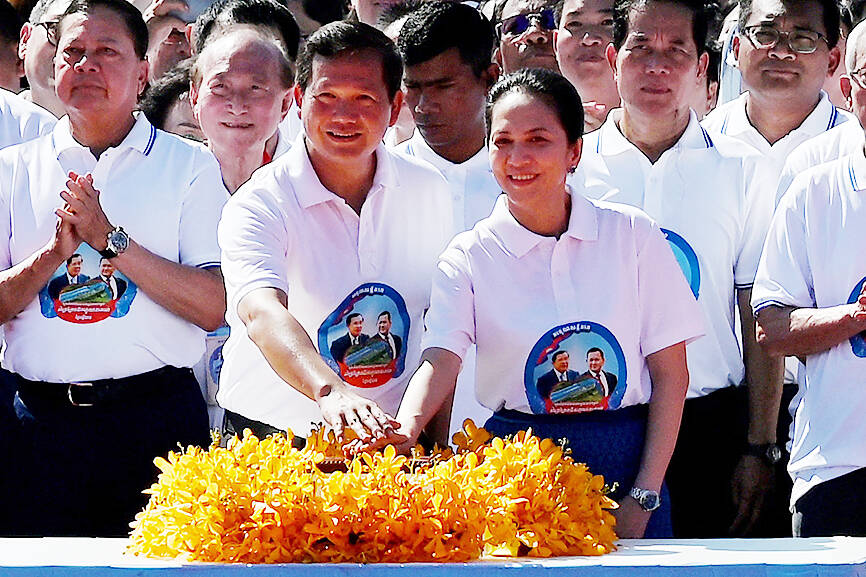Cambodian Prime Minister Hun Manet yesterday launched a controversial US$1.7 billion canal project that aims to provide a new link from the Mekong River to the sea.
At a launch event in Prek Takeo, southeast of the capital, Phnom Penh, Hun Manet called the 180km project “historic,” as drums sounded and fireworks shot into the air.
The event was attended by thousands wearing T-shirts bearing images of Hun Manet and his father, Hun Sen, who ruled the nation for nearly four decades.

Photo: AFP
“We must build this canal at all costs,” said Hun Manet, who drew cheers as he launched the project by pressing a ceremonial button with his wife, Pich Chanmony.
The Funan Techo Canal is to run from a spot on the Mekong, about an hour’s drive southeast of Phnom Penh, to the sea in the Gulf of Thailand and is due to be completed in 2028.
About one-third of cargo coming to and from Cambodia uses Vietnamese ports via the Mekong, but authorities hope that number would fall to about 10 percent once the canal is completed.
The limited capacity of the waterway — 100m wide and 5.4m deep — has raised questions about whether the lofty economic goals can be reached.
The project also comes shrouded in uncertainty, including its main purpose — whether for shipping or irrigation — who would fund it and how it would affect the flow of the Mekong — one of the world’s longest rivers.
Conservationists have long warned that the river, which supports up to one-quarter of the world’s freshwater fish catch and half of Vietnam’s rice production, is at risk from infrastructure projects, pollution, sand mining and climate change.
Cambodia, Laos, Vietnam and Thailand are signatories to the 1995 Mekong River Agreement, which governs the distribution of the river’s resources.
Cambodia has notified the Mekong River Commission of its plans for the canal, but Vietnam wants more information about the project.
Phnom Penh argues that the project affects only a Mekong tributary and therefore requires only the notification it has already submitted.
The canal, one of former Cambodian prime minister Hun Sen’s signature infrastructure projects, is seen as a galvanizing national undertaking to build support for his successor and son.
Hun Sen has described the canal as giving the nation a “nose to breathe through.”
The Cambodian government says the project would offer an alternative for container ships that currently cross into Vietnam before heading to the sea, allowing Cambodia to keep transport revenue in-country.
It says it is planning riverside economic zones along the route that it says could create tens of thousands of jobs for the nation, which is among the poorest in Southeast Asia.
However, villagers living along the projected route of the canal spoke about their anguish at having their homes expropriated as construction gets under way.
Some, who live near the canal, said they were not invited to join the event, saying they watched the ceremony from home with mixed feelings.
“We feel both happy and worried because we have not been informed about the compensation,” said a 51-year-old woman, who asked not to be named. “We are asking for an appropriate compensation. People told us that when there are developments, there are tears. So we are worried about that.”
Cambodian Deputy Prime Minister Sun Chanthol, who spearheaded the project, said at the event that the canal would benefit 1.6 million people and create “thousands of jobs.”
He promised that the government would provide “fair compensation” to those affected by the project.
Rights activists point to a pattern of expropriation for infrastructure projects that has left people struggling to relocate with minimal compensation.
Last year, China Road and Bridge Corp (CRBC), a Chinese construction giant that has financed other infrastructure in Cambodia, agreed to a feasibility study of the project.
Cambodian officials have suggested the Chinese state-owned company could finance part of the canal, but CRBC has not released its study or made any public commitment.
While Cambodia is a close ally of Beijing, Hun Sen has denied the canal would be part of China’s Belt and Road Initiative.
The project has sparked fears in neighboring Vietnam that the canal could be used by Chinese warships.
Cambodia and China held their largest annual military exercises in May, involving several Chinese military vessels and hundreds of military personnel.
In December last year, two Chinese warships made a first visit to a Cambodian naval base that the US says could be used to boost China’s influence in the Gulf of Thailand.
Cambodian officials have repeatedly denied that the base, near the port city of Sihanoukville, is for use by any foreign power.

Eleven people, including a former minister, were arrested in Serbia on Friday over a train station disaster in which 16 people died. The concrete canopy of the newly renovated station in the northern city of Novi Sad collapsed on Nov. 1, 2024 in a disaster widely blamed on corruption and poor oversight. It sparked a wave of student-led protests and led to the resignation of then-Serbian prime minister Milos Vucevic and the fall of his government. The public prosecutor’s office in Novi Sad opened an investigation into the accident and deaths. In February, the public prosecutor’s office for organized crime opened another probe into

RISING RACISM: A Japanese group called on China to assure safety in the country, while the Chinese embassy in Tokyo urged action against a ‘surge in xenophobia’ A Japanese woman living in China was attacked and injured by a man in a subway station in Suzhou, China, Japanese media said, hours after two Chinese men were seriously injured in violence in Tokyo. The attacks on Thursday raised concern about xenophobic sentiment in China and Japan that have been blamed for assaults in both countries. It was the third attack involving Japanese living in China since last year. In the two previous cases in China, Chinese authorities have insisted they were isolated incidents. Japanese broadcaster NHK did not identify the woman injured in Suzhou by name, but, citing the Japanese

YELLOW SHIRTS: Many protesters were associated with pro-royalist groups that had previously supported the ouster of Paetongtarn’s father, Thaksin, in 2006 Protesters rallied on Saturday in the Thai capital to demand the resignation of court-suspended Thai Prime Minister Paetongtarn Shinawatra and in support of the armed forces following a violent border dispute with Cambodia that killed more than three dozen people and displaced more than 260,000. Gathered at Bangkok’s Victory Monument despite soaring temperatures, many sang patriotic songs and listened to speeches denouncing Paetongtarn and her father, former Thai prime minister Thaksin Shinawatra, and voiced their backing of the country’s army, which has always retained substantial power in the Southeast Asian country. Police said there were about 2,000 protesters by mid-afternoon, although

MOGAMI-CLASS FRIGATES: The deal is a ‘big step toward elevating national security cooperation with Australia, which is our special strategic partner,’ a Japanese official said Australia is to upgrade its navy with 11 Mogami-class frigates built by Japan’s Mitsubishi Heavy Industries, Australian Minister for Defence Richard Marles said yesterday. Billed as Japan’s biggest defense export deal since World War II, Australia is to pay US$6 billion over the next 10 years to acquire the fleet of stealth frigates. Australia is in the midst of a major military restructure, bolstering its navy with long-range firepower in an effort to deter China. It is striving to expand its fleet of major warships from 11 to 26 over the next decade. “This is clearly the biggest defense-industry agreement that has ever